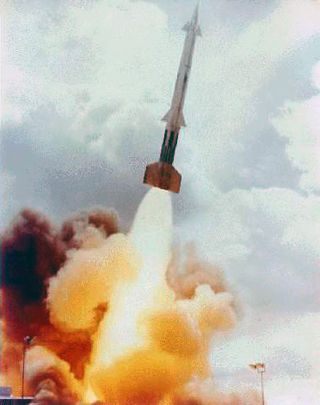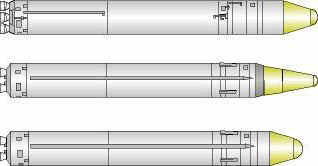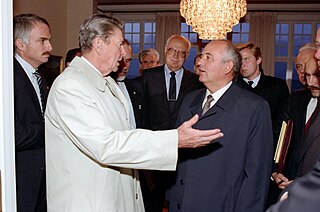Related Research Articles

The Anti-Ballistic Missile Treaty (1972–2002) was an arms control treaty between the United States and the Soviet Union on the limitation of the anti-ballistic missile (ABM) systems used in defending areas against ballistic missile-delivered nuclear weapons. It was intended to reduce pressures to build more nuclear weapons to maintain deterrence. Under the terms of the treaty, each party was limited to two ABM complexes, each of which was to be limited to 100 anti-ballistic missiles.

An intercontinental ballistic missile (ICBM) is a ballistic missile with a range greater than 5,500 kilometres (3,400 mi), primarily designed for nuclear weapons delivery. Conventional, chemical, and biological weapons can also be delivered with varying effectiveness, but have never been deployed on ICBMs. Most modern designs support multiple independently targetable reentry vehicle (MIRVs), allowing a single missile to carry several warheads, each of which can strike a different target. Russia, the United States, China, France, India, the United Kingdom, Israel, and North Korea are the only countries known to have operational ICBMs.

The Strategic Arms Limitation Talks (SALT) were two rounds of bilateral conferences and corresponding international treaties involving the United States and the Soviet Union. The Cold War superpowers dealt with arms control in two rounds of talks and agreements: SALT I and SALT II.

National missile defense (NMD) is a generic term for a type of missile defense intended to shield an entire country against incoming missiles, such as intercontinental ballistic missile (ICBMs) or other ballistic missiles.

The Strategic Rocket Forces of the Russian Federation or the Strategic Missile Forces of the Russian Federation is a separate-troops branch of the Russian Armed Forces that controls Russia's land-based intercontinental ballistic missiles (ICBMs).

START II was a bilateral treaty between the United States and Russia on the Reduction and Limitation of Strategic Offensive Arms. It was signed by US President George H. W. Bush and Russian President Boris Yeltsin on 3 January 1993, banning the use of multiple independently targetable re-entry vehicles (MIRVs) on intercontinental ballistic missiles (ICBMs). Hence, it is often cited as the De-MIRV-ing Agreement.

The RT-2PM2 «Topol-M» is one of the most recent intercontinental ballistic missiles to be deployed by Russia, and the first to be developed after the dissolution of the Soviet Union. It was developed from the RT-2PM Topol mobile intercontinental ballistic missile.

The RT-2PM Topol is a mobile intercontinental ballistic missile designed in the Soviet Union and in service with Russia's Strategic Missile Troops. As of 2014, Russia planned to replace all RT-2PM ICBMs with versions of Topol-M.

Missile defense is a system, weapon, or technology involved in the detection, tracking, interception, and also the destruction of attacking missiles. Conceived as a defense against nuclear-armed intercontinental ballistic missiles (ICBMs), its application has broadened to include shorter-ranged non-nuclear tactical and theater missiles.

The UR-100N, also known as RS-18A is an intercontinental ballistic missile in service with Soviet and Russian Strategic Missile Troops. The missile was given the NATO reporting name SS-19 Stiletto and carries the industry designation 15A30.

The Reykjavík Summit was a summit meeting between U.S. President Ronald Reagan and General Secretary of the Communist Party of the Soviet Union Mikhail Gorbachev, held in Reykjavík, Iceland, on 11–12 October 1986. The talks collapsed at the last minute, but the progress that had been achieved eventually resulted in the 1987 Intermediate-Range Nuclear Forces Treaty between the United States and the Soviet Union.

The RSM-56 Bulava is a submarine-launched ballistic missile (SLBM) developed for the Russian Navy and deployed in 2013 on the new Borei class of ballistic missile nuclear submarines. It is intended as the future cornerstone of Russia's nuclear triad, and is the most expensive weapons project in the country. The weapon takes its name from bulava, a Russian word for mace.
START III was a proposed bilateral arms control treaty between the United States and Russia that was meant to reduce the deployed nuclear weapons arsenals of both countries drastically and to continue the weapons reduction efforts that had taken place in the START I and START II negotiations. The framework for negotiations of the treaty began with talks in Helsinki between US President Bill Clinton and Russian President Boris Yeltsin in 1997. However, negotiations broke down, and the treaty was never signed.

Launch on warning (LOW), or fire on warning, is a strategy of nuclear weapon retaliation that gained recognition during the Cold War between the Soviet Union and the United States. With the invention of intercontinental ballistic missiles (ICBMs), launch on warning became an integral part of mutually-assured destruction (MAD) theory. Under the strategy, a retaliatory strike is launched upon warning of enemy nuclear attack while its missiles are still in the air and before detonation occurs. US land-based missiles can reportedly be launched within 5 minutes of a presidential decision to do so and submarine-based missiles within 15 minutes.

Russia and the United States maintain one of the most important, critical and strategic foreign relations in the world. Both nations have shared interests in nuclear safety and security, nonproliferation, counterterrorism, and space exploration.
On 26 September 1983, during the Cold War, the nuclear early-warning radar of the Soviet Union reported the launch of one intercontinental ballistic missile with four more missiles behind it, from bases in the United States. These missile attack warnings were suspected to be false alarms by Stanislav Petrov, an engineer of the Soviet Air Defence Forces on duty at the command center of the early-warning system. He decided to wait for corroborating evidence—of which none arrived—rather than immediately relaying the warning up the chain-of-command. This decision is seen as having prevented a retaliatory nuclear attack against the United States and its NATO allies, which would likely have resulted in an escalation to a full-scale nuclear war. Investigation of the satellite warning system later determined that the system had indeed malfunctioned.
This timeline of nuclear weapons development is a chronological catalog of the evolution of nuclear weapons rooting from the development of the science surrounding nuclear fission and nuclear fusion. In addition to the scientific advancements, this timeline also includes several political events relating to the development of nuclear weapons. The availability of intelligence on recent advancements in nuclear weapons of several major countries is limited because of the classification of technical knowledge of nuclear weapons development.

Ukraine, a republic of the former Union of Socialist Soviet Republics (USSR) from 1922–1991, once hosted Soviet nuclear weapons and delivery systems on its territory. Together with Russia, Ukraine was a part of the former Soviet Union but its population voted overwhelmingly for independence in 1991, which ended any realistic chance of the Soviet Union staying together even on a limited scale.

New START is a nuclear arms reduction treaty between the United States and the Russian Federation with the formal name of Measures for the Further Reduction and Limitation of Strategic Offensive Arms. It was signed on 8 April 2010 in Prague, and after ratification it entered into force on 5 February 2011.
The Moscow Summit of 1998 was a summit meeting happened on September 1–2, 1998, between President Bill Clinton and president of Russia Boris Yeltsin. The Moscow summit meeting addressed a number of important nonproliferation and arms control issues where the presidents of both countries discussed common security concerns and agreed to give each other's countries continuous information on launches of ballistic missiles in order to increase the safety of the population and reduce the possibility of nuclear war by mistake.
References
- ↑ "Text of Moscow Declaration by President Clinton and Russian President Yeltsin, Moscow, Russia, January 14, 1994". Federation of American Scientists. 1998. Retrieved September 21, 2007.
- ↑ "DEFENSE DEPARTMENT REPORT, TUESDAY, MAY 31". Federation of American Scientists. 1998. Retrieved September 21, 2007.
- ↑ "DETARGETING OF RUSSIAN INTERCONTINENTAL BALLISTIC MISSILES". Federation of American Scientists. 1998. Retrieved September 21, 2007.